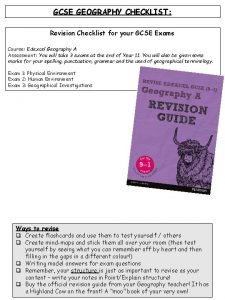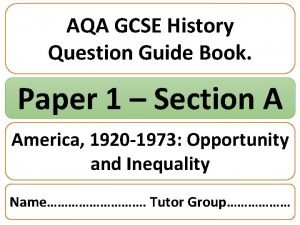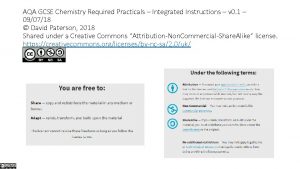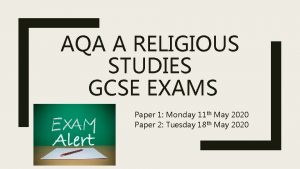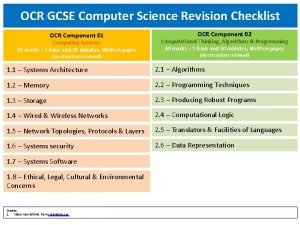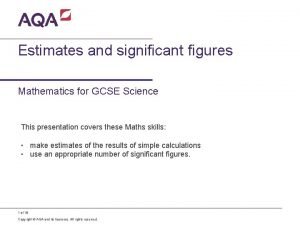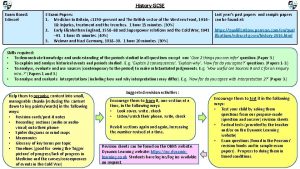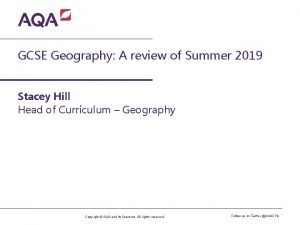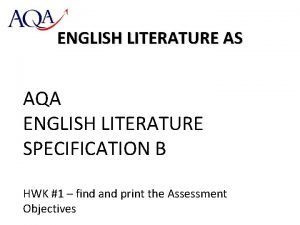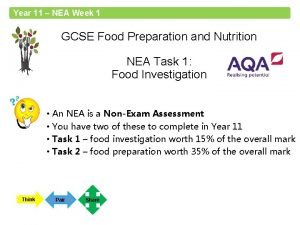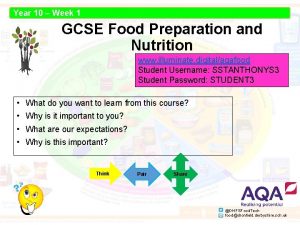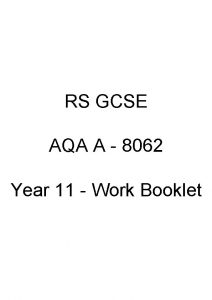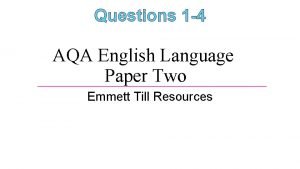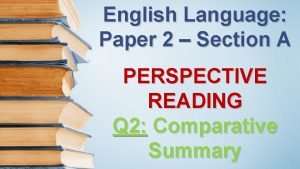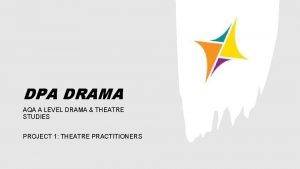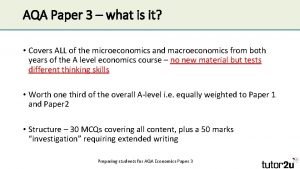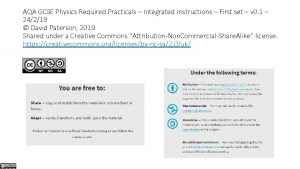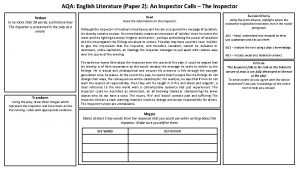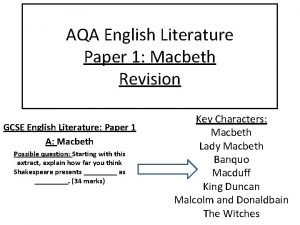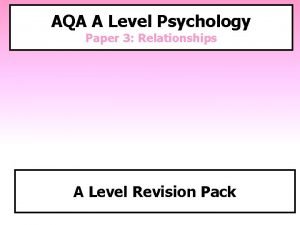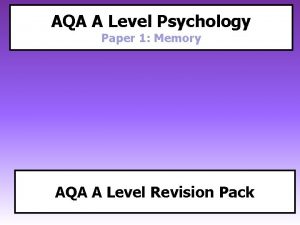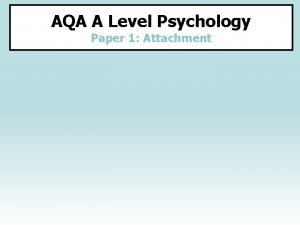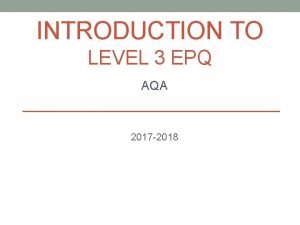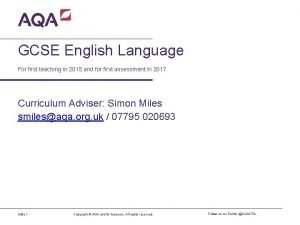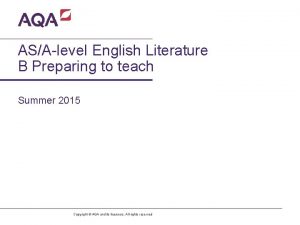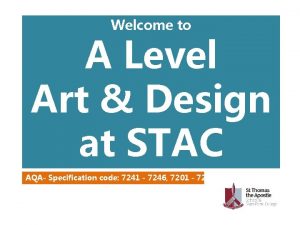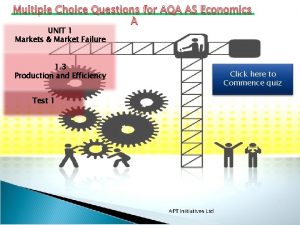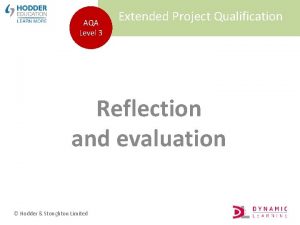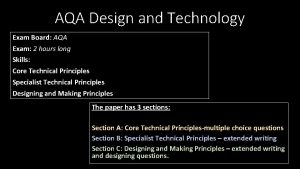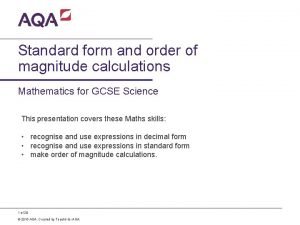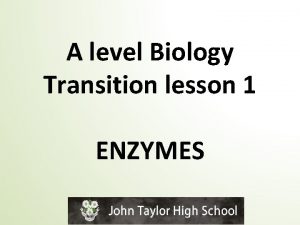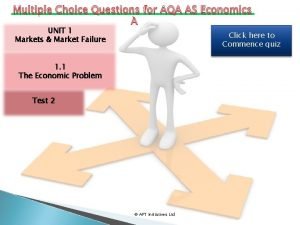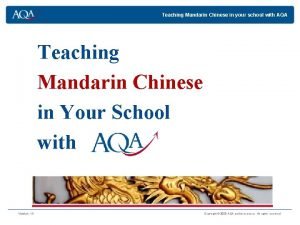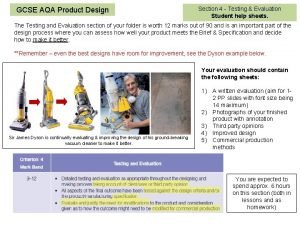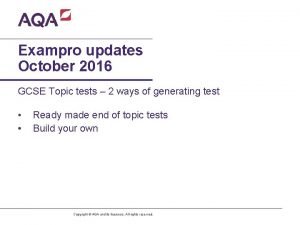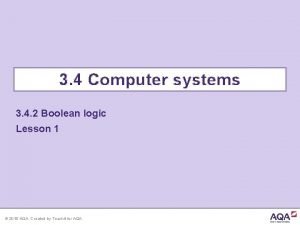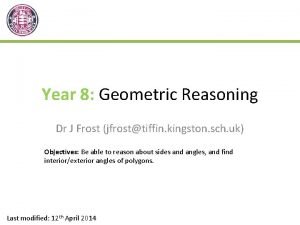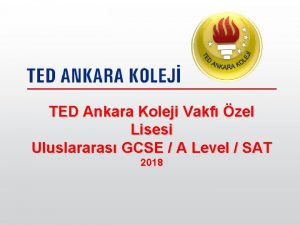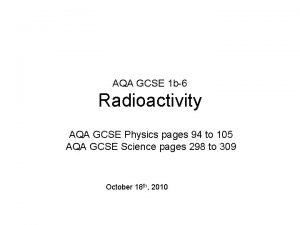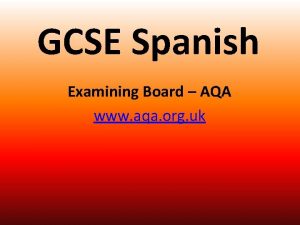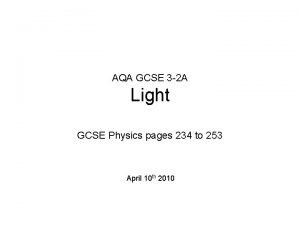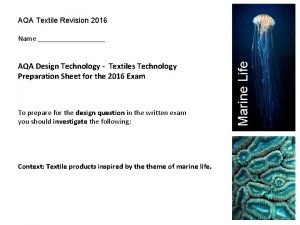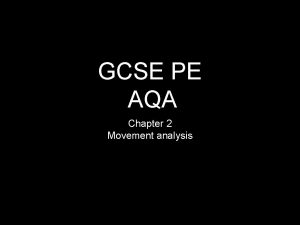AQA GCSE PE Chapter 3 AQA GCSE PE

























































































- Slides: 89

AQA GCSE PE Chapter 3

AQA GCSE PE Objectives: • • Chapter 3 – The relationship between health and fitness – The components of fitness – How to evaluate the need for components of fitness in specific physical activities and sport – Reasons for carrying out fitness tests – The protocol and procedures which should be followed when carrying out fitness tests – The limitations of carrying out fitness tests – How qualitative and quantitative data can be gained and used when fitness testing – The principles of training and overload and how they can be applied to training programmes – The varying training types and the advantages and disadvantages of using them – How training can be structures into seasons – The reasons for warming up and cooling down

AQA GCSE PE The relationship between health and fitness Health: A state of complete physical and mental and social wellbeing and not merely the absence of disease or infirmity. Fitness: The ability to meet/cope with the demands of the environment

AQA GCSE PE The relationship between health and fitness You have 3 minutes of state your agreement/disagreement to the below statement. “I am fit therefore I am healthy. ”

AQA GCSE PE The relationship between health and fitness Looking at the key terms for health and fitness, it is important to fully appreciate the relationship between health and fitness. It perhaps seems obvious that if you are in a good state of fitness, you are more likely to be healthy – certainly physically, but also mentally. Developing a good fitness level allows you to cope better with the demands of your daily life and environment and can help lesson the potential to be affected by illness and disease.

AQA GCSE PE The relationship between health and fitness However, it is important to realise that irrespective of how fit you are, there is always the potential to become unwell, i. e. suffer poor health. The relationship between health and fitness can be summaries in the following points. – Ill health can negatively affect fitness as the individual may be too unwell to train – thus lowering their fitness – Ill health may not affect fitness if the person is still well enough to train – Increase in fitness can positively affect health and well-being, e. g. you may be less likely to contract certain illnesses and diseases, you may feel content/happy within yourself and you may have enhanced your social well-being through taking part in activities – However, increase fitness cannot prevent you from contracting some illnesses and diseases and subsequently your health my suffer – Over training can in fact lower your immune system and make you more susceptible to illness and disease.

AQA GCSE PE

AQA GCSE PE

AQA GCSE PE What do I need to know about each component of fitness? q. Component name q. Component definition q. Component examples in a number of sports or skills q. Justification of the components requirement in example sports q. The fitness test for the component q. How to carry out the fitness test

AQA GCSE PE Agility The ability to move and change direction at speed whilst maintaining control. What other components are combined within agility? Speed, co-ordination, reaction time and strength A footballer who does need to change direction quickly does so to outwit another player, or to maneuver themselves into a suitable position to pass or shoot.

AQA GCSE PE Agility Example sporting scenario Justification Rugby player Needs to change direction to avoid a tackler or to perform a side-step Hockey player Badminton player Dancer

AQA GCSE PE Why do we fitness test? o To identify strengths and/or weaknesses in a performance. Are their reasons for the performance levels? E. g. poor dribbling linked to lack of speed o To inform your training requirements. Specific components that had poor scores, they may need to be priorities o To show starting level of fitness o To monitor improvement o To gauge the success of a training program o To compare against norms of the group o To motivate and set goals o To provide variety in a training program

AQA GCSE PE Agility Illinois agility test: ü Equipment needed: 8 cones, measuring tape, stopwatch ü The cones should be arranged in a 10 m x 5 m rectangle with 4 cones down the middle Ø Performer starts face down on the floor Ø The test involves running round the cones as fast as possible (is it a maximal test) Ø It is timed in seconds, and Ø It can be compared to the ratings below

AQA GCSE PE Balance The maintenance of the center of mass over the base of support There are two types of balance: v Static balance (balancing whilst still), v Dynamic balance (maintaining balance whilst moving) An example of static balance is when performing a headstand, which is in a held position. An example of dynamic balance is simply when walking or, more complexly, when a snowboarder aims to not fall over when making their descent downhill

AQA GCSE PE Balance Gymnastics example Handstand Headstand Cartwheel along a beam Tumble Type of balance Justification Position of handstand has to be held whilst maintaining control e. g. no wobbles,

AQA GCSE PE Balance The ‘stork balance’ test: ü Equipment needed: A stopwatch Ø The individual starts balanced on two feet flat Ø Hands are placed on the hips Ø One leg is lifted so that the toes of the lifted leg touch the inside of the knee of the planted leg Ø The timekeeper tells the individuals to raise the heel on the planted leg Ø The individual balances on one leg for as long as possible until they lose balance or have to move the toes attached to the inside of the knee Ø The time is recorded in minutes/seconds Ø The test can be repeated and scores are compared to the normative data

AQA GCSE PE Cardio-vascular endurance The ability of the heart and lungs to supply oxygen to the working muscles. Cardio-vascular endurance can also be called ‘aerobic power’. It is linked closely to stamina, which is being able to exercise whilst delaying the onset of fatigue. Cardio-vascular endurance is particularly important for sports performers who: Ø Perform long, enduring events Ø Performing using the aerobic energy systems (using oxygen) Thus you can say cardio-vascular endurance is important for long distance runner, team sports performers, endurance cyclists and rowers.

AQA GCSE PE Cardio-vascular endurance Marathon runner: Marathon runners complete 26. 2 miles (40 km). It is a long, grueling event that requires the athlete to make best use of their aerobic energy system. Compare two marathon runners with differing levels of cardio-vascular endurance and the effect it will have on their completion of a marathon. Javelin thrower: As an event, javelin lasts only a few seconds and is explosive and powerful. It does not matter if a javelin thrower can supply oxygen to the working muscles for a long period of time. Thus, cardio-vascular endurance is not required by a javelin thrower

AQA GCSE PE Cardio-vascular endurance The multi-stage fitness test: ü Equipment needed: Cones, tape measure (20 m or more), tape/CD with test, recording sheet Ø It is run over a distance of 20 m Ø It is progressive, i. e. it progressively gets harder Ø Individuals run 20 m in time with ‘bleeps’ Ø The time between bleeps gets shorter as the levels increase Ø The individual keeps running until they cannot keep up with the beeps – N. B. if you do not get to the line in time, the individual is usually given 1 or 2 more attempts to ‘catch up’ with the timings of the bleeps Ø The score is recorded as a level and bleep, e. g. Level 8 bleep 4. The score can provide a prediction of an individuals VO 2 max

AQA GCSE PE Co-Ordination The ability to use different (two or more) parts of the body together smoothly and efficiently. The nervous signals from the brain are times to ensure effective use of appropriate muscles, e. g. signals are sent to the shoulders, arms and hands to catch a ball. Some examples of co-ordination being used in sport include: Ø Hitting a cricket ball with a batt (hand-eye co-ordination) Ø Kicking a football ( foot-eye co-ordination) Ø Arms and legs when dribbling a basketball (arms-legs coordinations

AQA GCSE PE Co-ordination The Anderson ball catch test: ü Equipment needed: Tennis ball, a flat wall, stopwatch, an observer Ø The tennis ball start in one hand Ø Both feet together, 2 m from the wall Ø Upon the command of ‘go’ the time starts – 30 seconds Ø The individual throws the ball against the wall and catches the ball with the opposite hand Ø This is repeated as many times as possible Ø Repeat the test twice. If the ball is dropped the time continues.

AQA GCSE PE Flexibility The range of movement possible at a joint. The joints of the body have maximum ranges of movement which differ in relation to the type of joint being used, e. g. a ball and socket allows a wider range of movement than a hinge joint. Good flexibility is beneficial as it can prevent individuals from sustaining an injury if their body moves out of the normal range of movement. Flexibility is required to different extents by different sports people. A gymnast usually needs a good range of movement in many of their joints to create the shapes and moves required in a floor routine, e. g. performing the splits.

AQA GCSE PE The sit and reach test: ü Equipment needed: sit and reach box, slider Flexibility Ø The individual adopts a sitting position on the floor with their legs straight Ø Shoes should be removed and feet should be flat against the sit and reach board. Ø The slider should be set to 14 cm to be in line with the toes Ø The individual reaches forward and pushes the sliders as far as possible

AQA GCSE PE Muscular endurance The ability of a muscle or muscle group to undergo repeated contractions avoiding fatigue. The repeated contractions cause a limb to carry out repeated movement. The ability of a muscle/muscle group to move a limb repeatedly is needed for activities such as middle distance running, rowing or swimming. Swimming strokes are repeated, forceful movements that need to be sustained.

AQA GCSE PE Muscular endurance The sit and reach abdominal curl conditioning test: ü Equipment needed: partners for participants, CD of test, gym mat Ø Individual lies on the mat in a sit-up position, partner supports ankles. Ø The participant sits up on the bleep and down on the bleep (staying in time) Ø The test is maximal Ø It is also progressive – the bleeps get faster Ø The score is how many sit-ups you complete

AQA GCSE PE Power/explosive strength (anaerobic power) The product of strength and speed, i. e. strength x speed The creation of ‘power’ is useful in many sporting skills, for example: Ø To generate power whilst kicking a football – kicking with strength and moving the leg with speed Ø To smash/spike a volleyball with power – hitting with strength, moving the arm at speed Ø To release a discus with power – releasing with strength. Moving the arm at speed

AQA GCSE PE Vertical jump test (sergeant jump test): ü Equipment needed: Wall ruler, usually 2 m Power Ø Feet flat, stand push the wall ruler with the fingertips as high as possible. Ø This provides the individuals ‘zero point’ Ø Apply chalk (or something to make a mark) to the finger tips Ø From a standing position, the individual jumps as high as possible marking the ruler with the chalk Ø The observer records he height jumped in cm

AQA GCSE PE Reaction Time The time to initiate a response to a stimulus The time take from the presentation of a stimulus to starting to initiate a response (e. g. gun sounding at the start of 100 m to starting to move out of the blocks (GUN)→ time to start reaction → ( reaction starts/movement starts)

AQA GCSE PE Reaction Time Ruler drop test: ü Equipment needed: a meter ruler Ø One person holds the metre ruler at the zero point (vertically) Ø The individual being tests places their thumb and index finger of their dominant hand around the ruler ( not touching it) at 50 cm Ø Without warning the ruler is released Ø The individual being test must react to the drop and catch the ruler as fast as they can (with their thumb and index finger) Ø The score to be recorded is in cm Ø The individual may have three attempts

AQA GCSE PE Speed The maximum rate at which an individual is able to perform a movement or cover a distance in a period of time. Distance divided by time. It is also defined as ‘putting the body parts through actions as quickly as possible’. Speed can be calculated as ‘distance divided by time’ Olympic sprinters show amazing speed, performing the 100 m in less than 10 seconds.

AQA GCSE PE Speed Ruler drop test: ü Equipment needed: two cones 30 m apart, tape measure, stopwatch Ø Use a flying star Ø The individual is timed running 30 m as fast as possible Ø The score in seconds is compared to ratings

AQA GCSE PE Strength The ability to overcome a resistance t relates to the force that can be produced by a muscle a group of muscles. This can be maximal, explosive, static or dynamic: ü Maximal, the largest force possible in a single maximal contraction, e. g. it can be related to a single punch in boxing. ü Dynamic (similar as muscular endurance) ü Explosive (similar as power) ü Static: the ability to hold a body part (limb) in a static position. Muscle length stays the same/maximum force that can be applied to an immovable object. E. g. rugby scrum when both teams push with same force and the scrum is not moving

AQA GCSE PE Strength One rep max test: ü Equipment needed: appropriate weights/resistance machine – usually a bar bell or bench press machine Ø Lift a weight one using the correct technique Ø If completed, attempt a heavier weight until the heaviest weights the individual can possibly lift once is discovered (one correctly completed repetition) Ø If a weight cannot be lifted a lighter weight should be used to calculated the maximum weight that can be lifted. Ø Calculations: Ø Take you 1 rep max weights and divide it by your body weight

AQA GCSE PE Strength Handgrip dynamometer test: ü Equipment needed: handgrip dynamometer Ø The dynamometer should be help in the individuals dominant hand. The arm should be at 90 degrees with the elbow against the body. Ø Grip may need to be adjusted to size Ø Squeeze with maximum effort and record score Ø Repeat three times and record best score.

AQA GCSE PE Limitations of fitness testing Ø Although there are numerous benefits from carrying out fitness tests it is fair to say that fitness tests also have their limitations. These can be summarised as: Ø Tests are often not sport specific and can be too general. Fro example, the ruler drop test is not something carried out in any sport. Ø They do not replicate movement of activities – very few sports involve direct running for 20 m up and down in a straight line like the multi-stage fitness test. Ø The do not replicate competitive conditions required in sports – major sporting events are performed under extreme pressure. Mary of the tests can be repeated/retired. Ø Many of the tests have questionable reliability. As most test are maximal, the individual must try their hardest in the test to gain an accurate score, thus motivation levels must be high. Also, as a partner sometimes measures your score – e. g. vertical jump test – it is possible that they will get the scoring wrong. Ø Test tests must be carried out with the correct procedures and protocols, otherwise scores will not be accurate or valid.

AQA GCSE PE Evaluating what tests are appropriate for different sporting performers.

AQA GCSE PE Qualitative and quantitative data Qualitative data refers to opinions. There does not need to be a score or number as such, it could simply be subjective appraisal – e. g. “I did well in that test” Quantitative data deals with quantities. The measurement is classified as a number or score.

AQA GCSE PE The principles of training and their application to personal exercise and training programmes

AQA GCSE PE The principles of training Method Explanation Example Specificity Training to the needs to the individual and the demands of the sport A springer doing more anaerobic, speed and power. Training the exact muscle group used and energy demands. Progressive Overload Working harder than normal through Frequency Intensity Time Type Week 1: 2 km Week 2: 3 km Week 4: 4 km Week 5: 5 km Reversibility If an individual stops or decrease their training level them fitness and performance is likely to drop. Injury/illness/demotivation Tedium Refers to boredom. Training should be altered and varied to prevent from this occurring.

AQA GCSE PE The principles of training Frequency Refers to how often someone trains. Normally training should take place three or more times a week. As fitness increases, the ability to train more often also becomes possible. Intensity Refers to how hard you train: how fast your run/how heavy the weight is that you are lifting etc. As fitness increases, the intensity should be suitably increased Time Refers to how long you train for. As fitness increases, the length of time spent training may well increase Type Refers to the type of training used, e. g. continuous training. The training type must remain suitable to gain specific fitness benefits that are required.

AQA GCSE PE Types of training 1. 2. 3. 4. 5. 6. 7. Circuit training Continuous training Fartlek training Interval training Plyometric training Static stretching Weight training What do I need to know? Explanation, application of principles of training, advantages, disadvantages.

AQA GCSE PE Circuit training

AQA GCSE PE Circuit training involves different exercises being organised in different areas (or stations). Each station is completely different from the next. Completing of all of the stations is called ‘a circuit’ Considerations: • One component or multiple components of fitness. • Space and equipment available. • Work to rest ratio Specificity: focusing on specific muscles/ aspects of training Progressive overload: when circuit is repeated should gradually get harder (Alter work to rest ratio) Reversibility: regular circuits should prevent loss of fitness Tedium: the variety of circuits will prevent boredom Frequency: 3 times a week Intensity: altering work to rest ratio/ adding weights Time: duration of the circuit

AQA GCSE PE Circuit training Select the sport of your choice an design an 8 station circuit session

AQA GCSE PE Circuit training Advantages: • Exercises chosen can be simple to complex • The circuit can be manipulated to train different things, e. g. repeated contraction of a muscle/muscle group to train muscular endurance • It can be varied to suit fitness level/age, etc. • It is easy to monitor and alter – progressive overload can be applied by altering the work/rest ratio Disadvantages: • An appropriate amount of space is required • It may require specialist equipment, e. g. medicine ball, benches • It is difficult to gauge an appropriate work/rest ratio at the start

AQA GCSE PE Continuous training

AQA GCSE PE Continuous training Involves any activity that can be sustained without rest and repeated over and over – e. g. running, walking, rowing and swimming. Continuous training is used to improve cardio-vascular endurance and involves working at a constant rate or intensity. This is often referred to as STEADY STATE EXERCISE Which energy system is it working? The difficulty or intensity should be hard enough to stress the body but with a suitable level of oxygen intake to ensure the exercise is ‘aerobic’ This is commonly measured through the use of your heart rate. Specificity: A runner will run, a swimmer will swim Frequency: 3 times a week Type: Should only be used for activities which are long and enduring

AQA GCSE PE Continuous training • • Advantages: Completed with little or not equipment Improves aerobic fitness Running can be done virtually anywhere It is simple to do – keep doing the same movement over and over Disadvantages: It can be boring/ tedious It can cause injury due to repetitive contractions It can be time consuming It does not allow match the demands of the sport, e. g. in basketball the players do not run at one speed continuously

AQA GCSE PE Continuous training Create a 6 week continuous training session demonstrating progressive overload

AQA GCSE PE Continuous training Calculating the correct intensity for continuous training Calculating maximum heart rate 220 – AGE Aerobic training = 60 -80% of MHR

AQA GCSE PE Fartlek training

AQA GCSE PE Like continuous training, fartlek training is generally used to improve cardio-vascular endurance. It is more varied that continuous training as the speed and intensity is varied. Fartlek training involves: Ø The speed being altered throughout – e. g. sprint, jog, walk, jog, sprint Ø Exercises being incorporated into the activity Ø Running on different terrains – e. g. running on the flat, on hills, etc. Ø Altering the intensity as this can allow the aerobic and anaerobic energy systems to be trained – e. g. the more sprints involved the more emphasis on the anaerobic system.

AQA GCSE PE Interval training

AQA GCSE PE Interval training ü Training method that incorporates periods of work followed by periods of rest, e. g. work, rest, work, rest HIIT ü High Intensity Interval Training: an exercise strategy alternating short periods of short intense anaerobic exercise with less intense recovery periods

AQA GCSE PE The intensity of interval training can be altered to suit the individual by altering the time working and the time resting: HIIT basically means: ü Short bursts of extreme effort with even shorter rest periods ü A 2; 1 work ratio is often used, e. g. 30 seconds work, 15 seconds rest Beginners to interval training may well start with ü 2 -3 HIIT sessions a week ü A 2; 1 work ratio which may involve 20 seconds work/10 seconds recovery – with the aim to increase this to 30 seconds work/15 seconds recovery

AQA GCSE PE Interval training • • Advantages: It burns body fat and calories quickly It can be altered easily to suit the individual It can be completed relatively quickly It can improve the anaerobic and aerobic energy systems Disadvantages: • Extreme work can lead to injury • High levels of motivation are needed to complete the work • It can lead to dizziness and feelings of nausea.

AQA GCSE PE Interval training suits sports that make use of either energy system. If you’re an elite performing athlete who needs energy systems to be train for you sport, you can incorporate come sessions of sport-specific HIIT work. For example v Sprints or high intensity dribbling for football players v Vertical jumps for volleyball and basketball players v Heavy bag interval work for boxers You can also vary the length of the intervals v High intensity anaerobic intervals can last anywhere from 10 -60 seconds v Low intensity and more aerobic internals can last serval minutes

AQA GCSE PE Plyometric training

AQA GCSE PE Plyometric training ü Plyometric is a type of training that is used to increase power (strength x speed) ü It typically takes the form of bounding, hopping or jumping but can include medicine ball work, ‘jump and clap’ press-ups and box work. ü The aim of plyometric is to use your body weight and gravity to stress the muscles involved.

AQA GCSE PE Box jumping ü The athlete jumps off the box ü As they land their quadriceps lengthen (eccentric contraction) ü This stores ‘elastic energy’ which can then be released through a further immediate jump ü The second jump make us of a stronger concentric contraction. ü Thus the eccentric contract has caused a stronger concentric contraction

AQA GCSE PE Plyometrics can be used by any athlete who requires power. A basketball player or a triple jumper may well use plyometric to increase their leg power for jumping. It is an excellent way to increase power but can result in injury die to the stress placed on the muscles and joints.

AQA GCSE PE Static stretching

AQA GCSE PE Static stretching – stretching to the limit and holding the stretch isometrically Isometric contraction – muscular contraction when the muscle does not shorten or lengthen – it stays the same length

AQA GCSE PE ü It is an excellent way to increase flexibility – the range of movement at a joint. ü Static stretch are often performed as part of a warm up or col down but can be a form of training themselves. They are used by performers who which to improve their flexibility, e. g. gymnastic and dancers. ü Stative stretching involves: ü Stretching to the limit ü Holding the stretch for approx 30 seconds ü Avoid over stretching as injury can occur ü Using the correct technique, e. g. avoid dangerous stretches such as straight-legged toe touches

AQA GCSE PE Advantage of static stretching: v It increases flexibility (the range of movement at a joint) v It can be done by virtually everyone v It is relatively safe. Disadvantages of static stretching: v It can be time consuming to stretch the whole body v Some muscle are easier to stretch than others v Over-stretching can cause injury.

AQA GCSE PE Weight training

AQA GCSE PE Weight training can be used by anyone and can involve the use of free weights, resistance machines or any object which can safely be lifted. The beauty of weight training is that is allows individuals to use and therefore individual’s muscles/muscle groups and can be designed to suit an individual’s needs. A tennis player may well design a weights sessions to improve the muscles of the upper body and to increase power through shots, whereas a marathon runner may use weights on the lower body to improve muscular endurance in the legs.

AQA GCSE PE Safety Weight training should follow many safety guidelines: o The exercise should be completed correctly using the correct technique, e. g. the back should not be bent when picking weights up. o If free weights are being used, a ‘spotter’ can be used to help in the initial lift, putting the weights down as to assist if the individual starts to struggle to lift the weight. o Children should not lift heavy weights as they can damage growing bones. o A thorough warm up should be completed lifting weights. o A period of rest should follow every set.

AQA GCSE PE Calculating the correct intensity for weight training. In order to calculate the correct intensity, it is important that the power training knows what muscles they aim to train and how they wish to train them. q One repetition (or rep) is completing one lift of the weights (up and down). q One set is the completion of a number of sets. In its simplest form, if an individual wishes to improve strength/power they tend to lift heavy weights and complete few reps. This can be calculated through knowing their one max rep.

AQA GCSE PE Strength/power training involves lifting heavy weights with a low number of reps: Ø This involves lifting over 70% of your one max rep with approximately three sets of 4 -8 reps. Ø E. g. if a one max rep for bench press is 100 kg then the individual may well lift a 70 kg barbell, completing 3 sets of 6 reps (to improve strength) Muscular endurance involved lifting lighter weights with a high number of reps: Ø The involved lifting below 70% of your one max rep with approximately three sets of 12 -15 reps. Ø E. g. if one rep max for bench press is 100 kg then the individual may well lift 50 kg barbell, completing 3 sets of 15 repetitions.

AQA GCSE PE Using your one rep max to help you calculate intensity also ensures that overload is occurring. Remember that the principles of training (SPORT) should always be applied so muscles being worked should be the ones usually used in the sport. Also, the choice of whether to calculate intensities for strength or muscular endurance will depend on the demand of the sport, e. g. marathon runners would tend to use muscular endurance whereas discus throwers would tend to need strength.

AQA GCSE PE Advantage of weight training: v It can easily be adapted for different fitness aims, e. g. muscular strength or muscular endurance. v It is relevant to all sports. v It is relatively straightforward to carry out – you simply need something to lift. v Strength gains can occur. Disadvantages of weight training: ü Heavy weights can increase blood pressure. ü Injury can occur if weights are too heavy or incorrect technique is used. ü Calculating one rep max requires high levels of motivation.

AQA GCSE PE Safety principles when training 1. The training type and the intensity us should match the training purpose, e. g. training for aerobic sports may well us continuous training at 60 -80% MHR 2. A warm up and cool down should be completed prior to and after training. 3. Over training should be avoided, e. g. appropriate weights should be lifted. 4. Appropriate clothing and footwear should be work which protect/support and allow movement. 5. Taping/bracing should be used as necessary to protect and support areas of weaknesses. 6. Hydration should be maintained with fluid intakes. 7. Technique used should be correct, e. g. lifting technique. 8. Appropriate rest should be given in between sessions to allow for recovery. 9. Spotters should be used when weight training if heavy weights are being attempted.

AQA GCSE PE SAFER – for revision S – stretches should be completed as part of a thorough warm up A – appropriate intensity should be used F – footwear and clothing should be appropriate to allow support/movement ER- Exercise and rest – allow appropriate rest in between exercise sessions.

AQA GCSE PE Specific training technique (high altitude training)

AQA GCSE PE Altitude training One specific training type used by elite athletes is that of high altitude training. High altitude training involved carrying out training a high altitude, i. e. high above sea level. Many athletes need to travel to different parts of the work in order to gain access to appropriate training areas at appropriate heights. High altitude training is a form of aerobic training, e. g. it trains the aerobic energy system and can improve a person’s cardiovascular endurance.

AQA GCSE PE Altitude training • The individual trains at a high altitude – usually 2000 m of more above sea level • There is less oxygen is the air at high altitude. This make training very difficult as the body finds it harder to carry oxygen to the working muscles. • As a result, the body compensates by making more red blood cells to carry what oxygen there is in the air.

AQA GCSE PE Altitude training benefits: • Endurance athletes – e. g. marathon runners • Athletes that work aerobically – i. e. athletes that sustain exercise over a long period of time Altitude training has virtually not benefit for anaerobic athletes.

AQA GCSE PE Altitude training High altitude training is a specific form of training and is complex in that many athletes need to travel to training in a foreign country. It has many limitations/negative effects: • It can be very difficult to complete training. Some people find it too hard and actually train less than if they were at sea level. • This means that fitness can actually be lost. • Some athletes can duffer from altitude sickness – a feeling of nausea. • The benefits are lots quite quickly – i. e. when returning to sea level, red blood cell count starts to decrease again.

AQA GCSE PE The three training seasons

AQA GCSE PE Although not all sports follow distinctive seasonal patterns, there are three ‘traditional’ parts to the training season which are still followed by many performers: § Pre-season (also known as preparation) § Competition season (also known as peak/playing season) § Post – season (also known as transition)

AQA GCSE PE Pre-season/preparation – the aim is to improve general and aerobic fitness. This is often done via aerobic training, e. g. long runs. It is also an aim to improve specific fitness needs so that the performer is ready for competitive season, e. g. agility for tennis. A swimmer may well undertake long duration swims, before working on specific aspects of their technique. Similarly a cyclist may attempt o increase their general and aerobic fitness on a bike, whilst also working on specific skill aspects like climbing.

AQA GCSE PE Competition/peak/playing season The aim is to maintain fitness levels. The performer should be at peak fitness and will aim to maintain this. They may well also work on specific skills used in their sport.

AQA GCSE PE Post-season/transition The aim is to rest and recover from the season. Many performers also continue some light aerobic training so that fitness levels do not drop too far.

AQA GCSE PE Effective use of warm up and cool down

AQA GCSE PE Warming up There are several parts that a good warm up should include in order to be fully effective: ü Gradual pulse raising activity – e. g. fast walk/jog/light swim to increase the amount of oxygen to the working muscles. ü Stretching – of all relevant muscles. ü Skill-based practices/familiarisation activities, e. g. ball work in football. ü Mental preparation – starting to get focused, using techniques to control arousal, e. g. deep breathing.

AQA GCSE PE Warming up benefits By completing these parts of a warm up, the individual will benefit in the following ways: ü Body temperature will increase ready for exercise. ü Stretching will increase the range of movement possible. ü There will be a gradual (not over demanding) increase in effort towards “competition pace”, i. e. you gradually work up to the intensity required for the game/event. ü You will be focused and psychologically prepared. ü Movement skills that will be used have been practised before starting the game/match/event. ü There will be less chance of suffering injury. ü There will be an increase in the amount of oxygen being carried to the working muscles – helping with the production of energy.

AQA GCSE PE Cooling down Performing a cool down is often overlooked and under-valued by sports performers. However, it holds a high level of importance and should not be ignored. An effective cool down should include: ü An activity to maintain an elevated breathing and heart rate, e. g. walk, jog. ü A gradual reduction in intensity, e. g. jog to light jog to walk

AQA GCSE PE Cooling down benefits The benefits of cooling down can be summarised as follows: ü It allows the body to start to recover after exercising. ü It helps with the removal of lactic acid, carbon dioxide and waste products. ü It can help to prevent the delayed onset of muscles soreness, sometimes referred to as DOMS.
 Gcse pe 9 mark question examples
Gcse pe 9 mark question examples Edexcel geography gcse checklist
Edexcel geography gcse checklist How to answer gcse history questions aqa
How to answer gcse history questions aqa Aqa gcse chemistry required practicals
Aqa gcse chemistry required practicals Gcse art and design aqa
Gcse art and design aqa Re gcse past papers
Re gcse past papers Anticipating misuse computer science
Anticipating misuse computer science Significant figures gcse
Significant figures gcse History gcse past papers
History gcse past papers Tangent questions
Tangent questions Aqa maths gcse revision guide
Aqa maths gcse revision guide How to answer a 12 mark question in history
How to answer a 12 mark question in history Kendal industrial park aqa
Kendal industrial park aqa Aqa english literature specification
Aqa english literature specification Task analysis food technology example
Task analysis food technology example Illuminate aqa food
Illuminate aqa food Aqa product design
Aqa product design Explain two contrasting understandings of salah
Explain two contrasting understandings of salah Reverse ratio
Reverse ratio Aqa english language paper 1
Aqa english language paper 1 Gcse geography manchester case study
Gcse geography manchester case study Edexcel gcse english language paper 2
Edexcel gcse english language paper 2 Jennifer obaditch
Jennifer obaditch Countercurrent exchange in fish
Countercurrent exchange in fish English language paper 2 rail disasters mark scheme
English language paper 2 rail disasters mark scheme Aqa english literature nea prohibited texts
Aqa english literature nea prohibited texts Steven berkoff fact file
Steven berkoff fact file Economics paper 3 aqa
Economics paper 3 aqa Aqa tols
Aqa tols Physics required practicals
Physics required practicals Is inspector calls paper 1 or 2
Is inspector calls paper 1 or 2 How to revise for english literature gcse
How to revise for english literature gcse Equity theory a level psychology
Equity theory a level psychology Memory a level psychology
Memory a level psychology Attachment a level psychology
Attachment a level psychology Aqa a level physics data sheet
Aqa a level physics data sheet Aqa epq artefact examples
Aqa epq artefact examples Homework has no value aqa model answer
Homework has no value aqa model answer Aqa customer service
Aqa customer service Aqa a level english literature b past papers
Aqa a level english literature b past papers Aqa a level art and design
Aqa a level art and design Aqa economics multiple choice questions
Aqa economics multiple choice questions Aqa
Aqa Extended project qualification aqa
Extended project qualification aqa Aqa design and technology past papers
Aqa design and technology past papers Art and design a level aqa
Art and design a level aqa Aqa merger of
Aqa merger of Magnitude calculations
Magnitude calculations Aqa
Aqa Aqa a level biology transition guide answers
Aqa a level biology transition guide answers Aqa a level chemistry paper 1 2020
Aqa a level chemistry paper 1 2020 Surface area gcse
Surface area gcse Aqa
Aqa Venn diagrams gcse
Venn diagrams gcse Aqa
Aqa Glastonbury festival and greenwich fair answers
Glastonbury festival and greenwich fair answers Aqa
Aqa 2x-30
2x-30 Economics multiple choice questions aqa
Economics multiple choice questions aqa Aqa
Aqa Aqa english literature paper 1 2019 a christmas carol
Aqa english literature paper 1 2019 a christmas carol Aqa
Aqa Aqa chinese
Aqa chinese Aqa product design specification
Aqa product design specification Aqa exampro
Aqa exampro Theme of ozymandias
Theme of ozymandias Behavioural approach to explaining phobias
Behavioural approach to explaining phobias Aqa a level history tudors past papers
Aqa a level history tudors past papers Aqa boolean algebra
Aqa boolean algebra Matt damon
Matt damon Labelled diagram of the heart gcse
Labelled diagram of the heart gcse Edexcel art gcse past papers
Edexcel art gcse past papers Why is the ascension important gcse
Why is the ascension important gcse Iamis structures
Iamis structures Hypertonic definition biology gcse
Hypertonic definition biology gcse Edexcel gcse english literature
Edexcel gcse english literature Public limited company gcse business
Public limited company gcse business Sine foundation
Sine foundation Tree diagrams gcse
Tree diagrams gcse Ocr
Ocr Pixl knowit gcse chemistry chemical changes
Pixl knowit gcse chemistry chemical changes Combined science grade boundaries
Combined science grade boundaries Gcse nedir
Gcse nedir Speed distance time gcse maths
Speed distance time gcse maths Wjecservices
Wjecservices Circuit training gcse pe
Circuit training gcse pe Hemisphere gcse questions
Hemisphere gcse questions Simple interest gcse questions
Simple interest gcse questions Scale drawing questions
Scale drawing questions Sample space diagram gcse questions
Sample space diagram gcse questions

